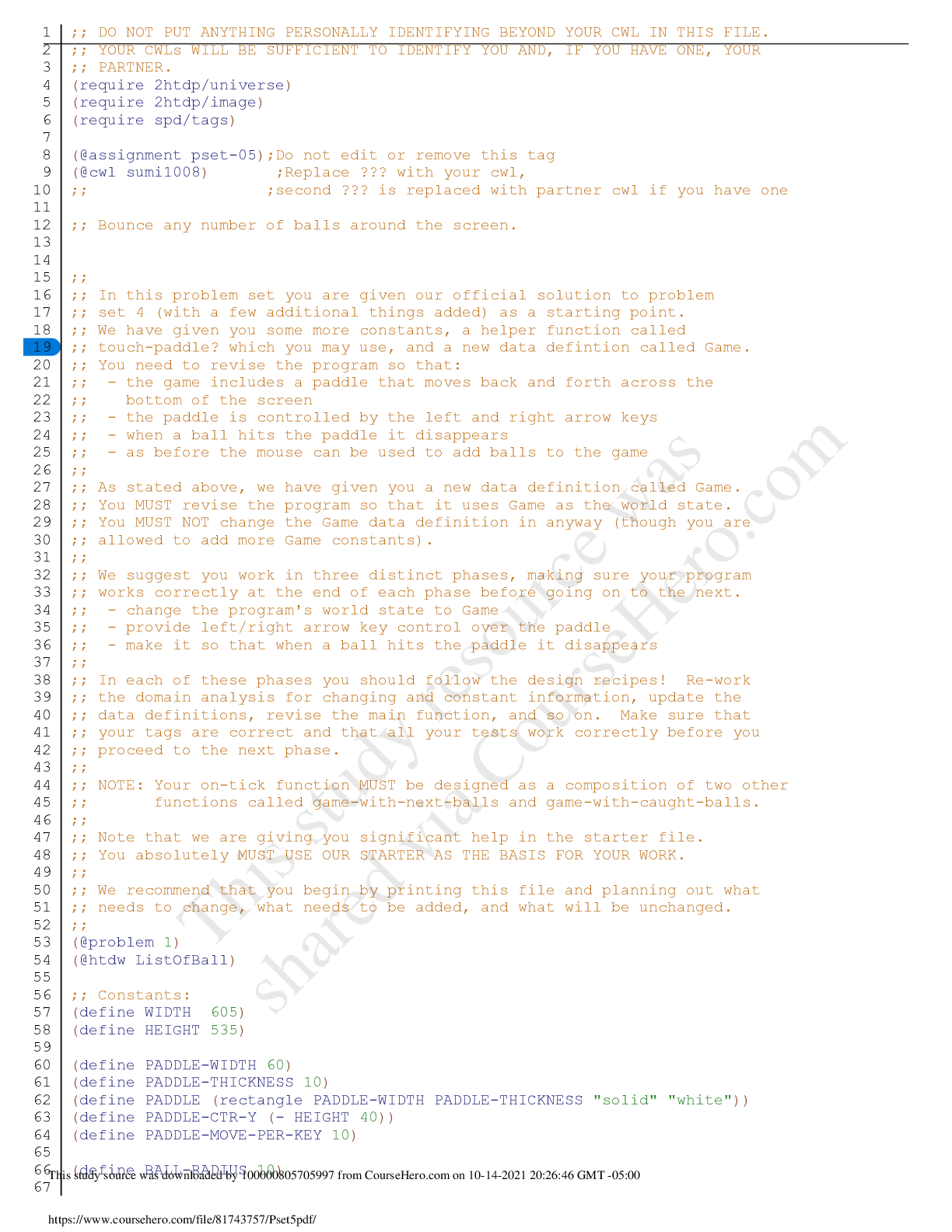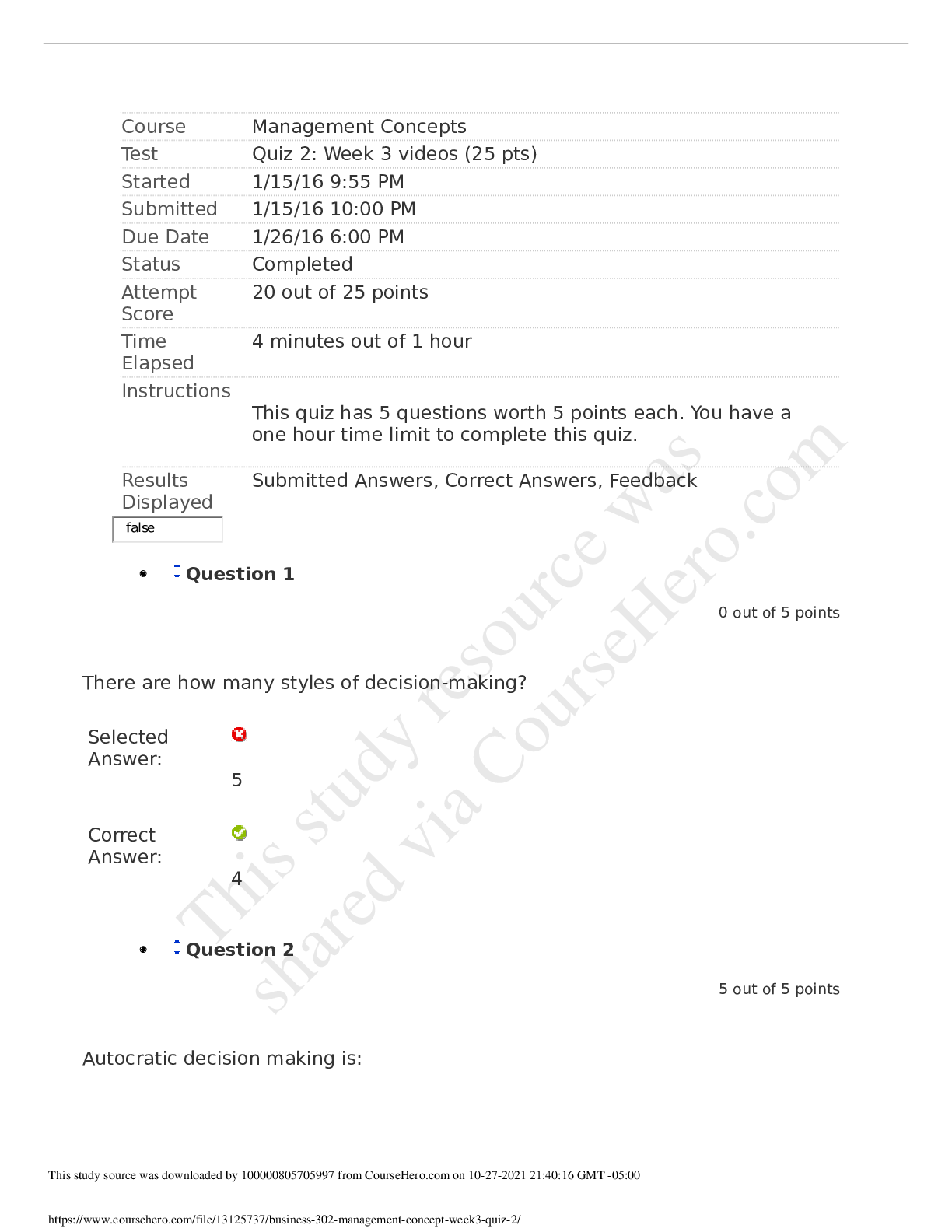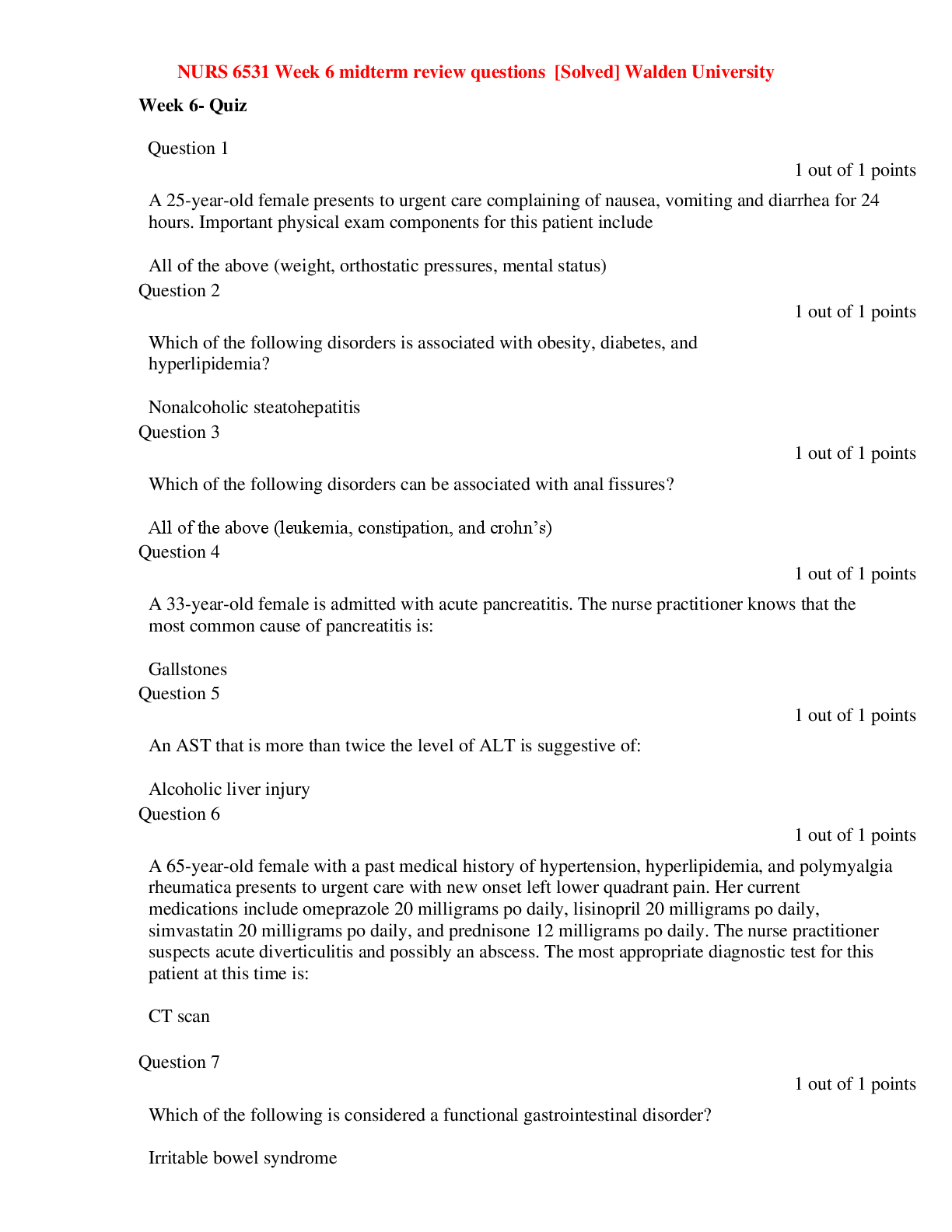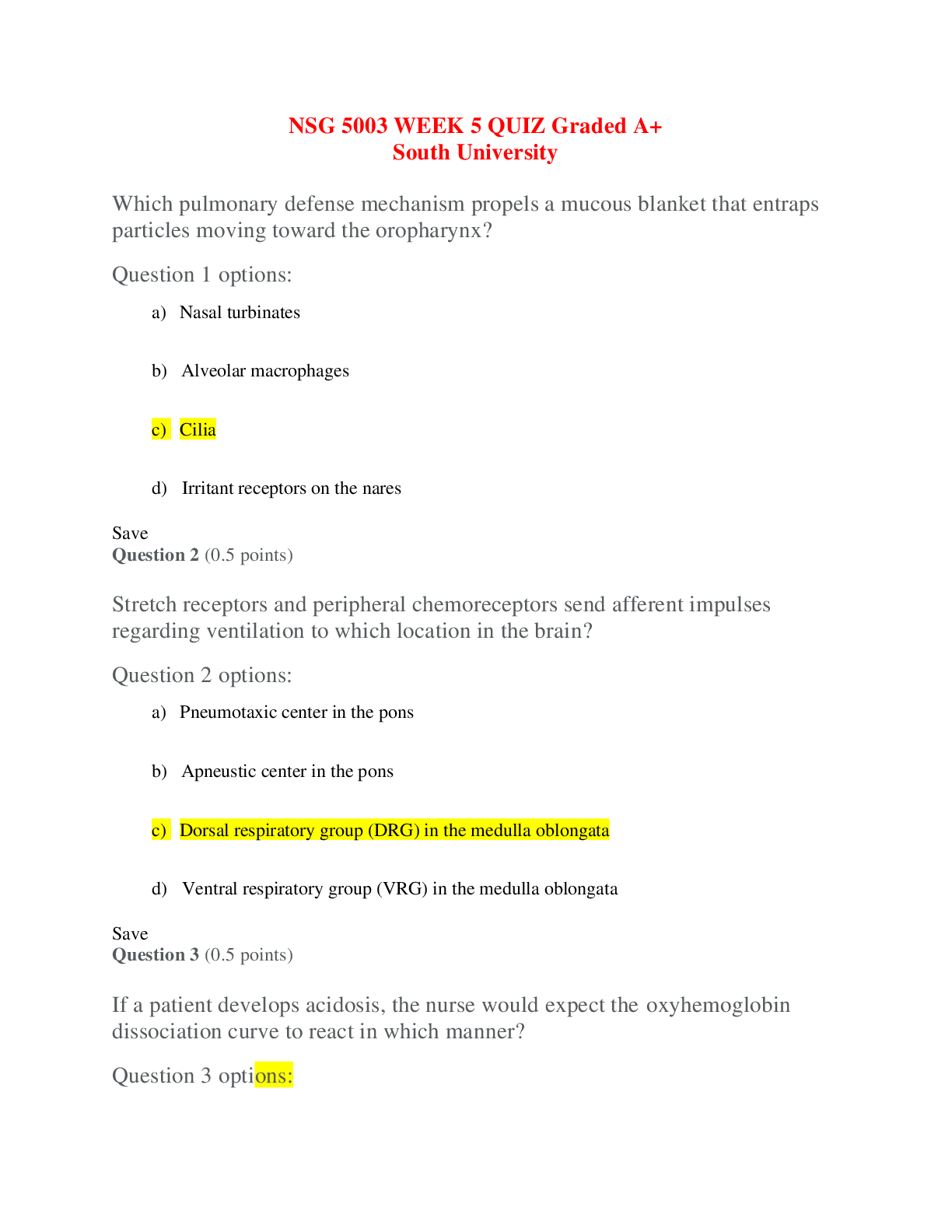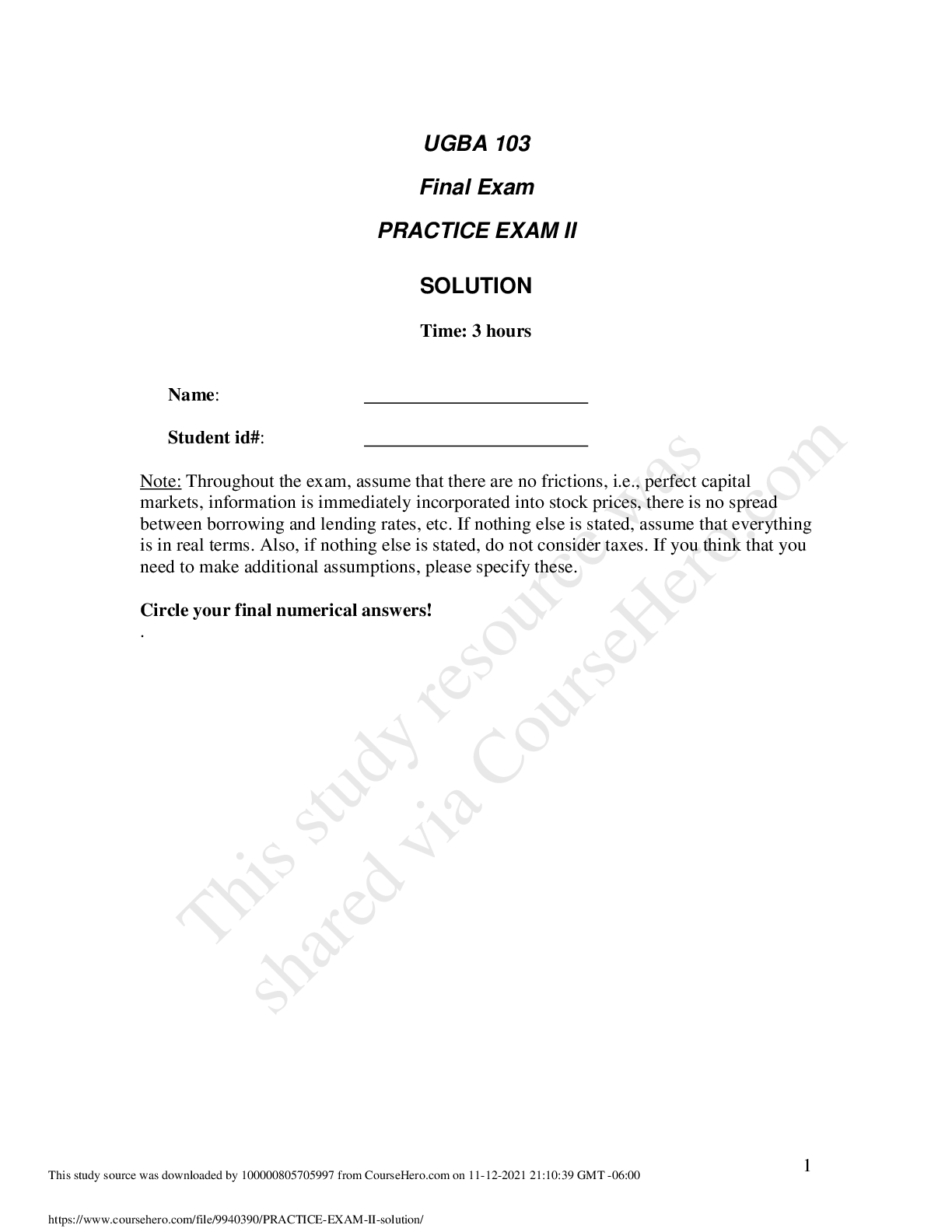Education > QUESTIONS & ANSWERS > [Solved] ANSWERS & RATIONALES to ASSIGNMENT #1 (All)
[Solved] ANSWERS & RATIONALES to ASSIGNMENT #1
Document Content and Description Below
ANSWERS & RATIONALES to ASSIGNMENT #1 (Basic Concepts of Pathophysiology & Implications for Nursing, Genetic Influence, Intracellular Functions) Academic honesty reminder: It is ok to discuss the as... signments with other students as a learning tool, but it is considered a breach of academic honesty to copy answers directly from each other. Also, when taking a test, do not have this or any other informational document visible. Basic Concepts of Pathophysiology & Implications for Nursing Questions 1 & 2 below refer to the following situation: A 55-year-old man with emphysema (a type of chronic lung disease) who has smoked 2 packs of cigarettes per day for 40 years is hospitalized for acute onset of cough productive of bloody sputum (sputum=secretions from deep in the lungs). After a few days of testing and treatment, the patient’s nurse reads a physician’s note on the chart: “I have told the patient that the etiologies of his hemoptysis are: 1) exacerbation of his chronic emphysema and 2) the new diagnosis of lung cancer. The onsets of both were contributed to by his longstanding smoking.” 1. The patient asks the nurse for more information. Which of the following explanations to the patient best indicates a full understanding of the patient’s situation? a. “You have a disease process that was iatrogenically caused by cigarette smoking.” Incorrect: “iatrogenically” means caused by a medical person. b. “You have a sudden onset of a chronic lung disease that was brought on by lung cancer.” Incorrect: the chronic lung disease was part of the medical history of the patient; the term “chronic” means a long-standing disease, not a “sudden onset.” c. “The coughing up of blood is caused by a worsening of a disease you’ve had for a long time plus a new problem-- lung cancer.” d. “These diseases have been creeping up on you for probably 20 years; it just goes to show that you should never have taken up smoking.” Incorrect: no evidence in the scenario to support this sentence. (Besides, it sounds very judgmental.) 2. Based on all the information you have on the patient, which statement is most likely correct? a. The patient has a poor prognosis because of the comorbidities of lung cancer and cigarette smoking. Incorrect: Smoking is a risk factor not a disease that would fit the term “comorbidity.” b. Lung cancer was a sequela of the bloody sputum. Incorrect: the bloody sputum was part of the S&S of cancer; this answer implies the bloody sputum caused the cancer. c. A precipitating factor for the acute hospitalization was overexertion when the patient started an exercise class. Incorrect: no evidence in the scenario to support this sentence. d. Heavy cigarette smoking was a risk factor in the patient’s developing emphysema and lung cancer. Questions 3 & 4 refer to the following situation: An 80-year-old patient is in shock from loss of blood following an accident. His vital signs are: BP 80/50 (normal ~ 120/80), HR 120 (norm = 60-100), RR 20 (norm = 12 to 20), T 98.6 (norm ~ 98.6). 3. In assessing this patient, the nurse understands that the abnormal HR is a. probably the etiology for the patient’s low BP. Incorrect: the shock is due to the “loss of blood.” A state of shock has a “big picture” of low BP, high HR, cool hands, weakness, feeling faint, and/or passing out. In this context the high HR doesn’t CAUSE the low BP. b. due to the patient’s heart compensating for low blood volume by pumping faster. c. the normal compensatory response of shunting blood volume to the periphery. Incorrect: shunting blood to the periphery IS a compensatory response, but it is a “co-response” with high HR; one doesn’t cause the other. d. due to multiple risk factors. Incorrect: no evidence in the scenario to support this sentence. (TIP: when you are deciding on answers, plug them each into the stem of the question & ask yourself if it makes sense. Ex—does this sentence make sense? “In assessing this patient, the nurse understands that the abnormal HR is due to multiple risk factors.” Hopefully you see that no, it doesn’t make sense.) 4. The patient would also most likely have all of the following EXCEPT a. S&S of cool feet and hands from the body’s compensatory response to shock. b. S&S of feeling faint and weak from blood loss. c. a risk factor of shock. In an except question, remind yourself that 3 things go together. The 4th one is the one you choose—it doesn’t fit. d. a more guarded (ie, “poorer”) prognosis because of his age. 5. A young, otherwise healthy patient is admitted to the hospital with a diagnosis of heart failure of unknown cause. The etiology of the heart failure would be termed a. iatrogenic. b. idiopathic. c. nosocomial. d. acute. 6. To do well in this course, a student should a. memorize the notes thoroughly. Incorrect: memorize only a few things that are unavoidable. Otherwise, study concepts and contexts! b. be able to apply concepts to different situations. c. begin each assignment Wednesdays at 7am. Incorrect: you should begin and try to finish assignments way before an hour before they are due! d. hurriedly take tests one hour before their stop-time. Incorrect: you should begin and finish tests way before an hour before they are due! Questions 7-10 refer to the following situation A 55 year old male is in the ER having a myocardial infarction (heart attack, AKA “M.I.”), which is caused by coronary arteries that are clogged with fat and narrowed so that not enough oxygen–rich blood is getting to his heart. He admits that his daily nutrition is poor, consisting mainly of high-fat fast food. He has a family history of cardiac disease-- his father had a heart attack at age 46. The patient is obese and is a heavy cigarette smoker-- 2 PPD (packs per day). The patient said he had decided to take up jogging today and after a few minutes began having chest pain, nausea and shortness of breath. He went to the ER and was noted to have profuse diaphoresis (heavy sweating), tachycardia (rapid heart rate), and significant changes on his electrocardiogram (ECG or EKG). The patient recovers from this acute heart attack but his heart is so damaged that subsequently he has many episodes of congestive heart failure and many hospitalizations. 3 7. Without even having further knowledge of course material related to MI’s, you can tell a lot about the scenario from careful reading and knowledge of basic patho verbiage. Example: The paragraph above suggests that the direct pathophysiologic etiology of the heart attack (MI) is most likely related to a. not eating green vegetables. Incorrect: not eating nutritiously is not a DIRECT patho etiology; we do have a hint that he has a risk factor of eating unhealthily (fast food), but don’t “overthink.” b. congestive heart failure. Incorrect: heart failure is a sequela in this context. c. lack of oxygen that narrows the coronary arteries. . Incorrect: the scenario tells you that the MI is “caused by coronary arteries that are clogged with fat and narrowed so that not enough oxygen–rich blood is getting to his heart.” It doesn’t say that oxygen causes the narrowing, which is what this answer says. d. oxygen not reaching tissue that is distal to narrowing of the coronary arteries. See sentence above… also, you are asked to use the knowledge from the RRD about what the term distal means. (See top of page 5 of RRD 1 for reviewing that info) 8. In reading the paragraph above, it is easy to find 4 risk factors—things that “set the stage” for this patient to have a heart attack. They include all the following EXCEPT a. being a heavy cigarette smoker. b. having profuse diaphoresis. This is the correct choice, because it is one of the S&S, not a risk factor. c. a parent with heart disease. d. high-fat diet. 9. Which mini-concept map do you think best describes accurate linkage between underlying pathophysiology and signs and symptoms (S&S) described in this scenario? a. Jogging increased heart rate!blood pumped throughout body faster!tissues (including lungs and stomach) receive too much blood!patient complains of shortness of breath and nausea. Incorrect: there is nothing about this situation that implies that “too much blood” is being pumped to the organs. b. History of heart disease in family!patient worries about it constantly!becomes anxious!smokes too much!nicotine causes narrowing of all arteries in body, including coronaries!heart attack from narrowed coronaries. c. High levels of fat in the blood from high-fat diet!clogs in coronary arteries develop over time !oxygenated blood cannot get to distal tissues of heart!unoxygenated tissues “cry out” (send pain messages to brain) ! patient complains of chest pain. d. Obesity! increased pressure on diaphragm!breathing becomes more difficult!shortness of breath!less oxygen! EKG changes. Note: Part of the key to understanding patho material and doing well on tests is paying close attention to the flow of the notes (RRDs) and then also these scenarios, as well as understanding what exactly the questions are asking. Also, go through each answer and be sure you have a really good rationale for why you chose the answer that you did and why you didn’t choose other answers. 4 10. A sequela of the MI was a. having to be hospitalized frequently because of problems associated with the damaged heart. b. having to be hospitalized frequently with repeat heart attacks. c. needing to jog more often. d. continuing to smoke 2 PPD. 11. The most likely sequela of not submitting a weekly assignment by Wednesdays at 8am is a. being allowed to submit the assignment later because you had a bad cold during the days leading up to the assignment due date. Incorrect: if a student waits till the last minute to submit an assignment, there is increased risk of something going wrong, such as not feeling well. b. getting a zero on that assignment. (If there are special, urgent contingencies, especially ones that have documentation, a student may email before the due date to explain why he or she cannot get the assignment in on time. The excuse may or may not be accepted and extra time may or may not be allowed, depending on the circumstances.) c. instructor’s lack of concern, because you will be able to drop the lowest assignment grade. Incorrect: no assignment grades are dropped d. being allowed to submit the assignment later because you thought it wasn’t due till the next day. Incorrect: In this course there are many reminders of due dates and consequences of not getting assignments and tests in on time. To be considered for late submission, a student needs a documented, urgent excuse. 12. At the end of the semester, a student has a total assignment average grade of 100% and a 69.7% total test average grade. What grade did the student make for this semester (see syllabus)? a. 84.85% (B) b. 69.7 % (D) (See box on last page of Course Overview or look in your syllabus) c. 71.43% (C) d. 93.03% (A) 13. Student Katniss Everdeen has been submitting her assignments and tests before the deadlines and making good grades. One day during an unexpected storm, her internet connection goes down in the middle of a test. Since she is a consistently focused and dedicated student, what action do you think she will take? She will a. email her coach that “A pack of wolfmutts attacked and ate my computer. Can I take the test tomorrow?” b. resign herself to getting a zero, since she didn’t read the procedures in the syllabus and Course Overview. c. take the test the next day, since she knows that multiple test entry and submission is allowed. d. immediately email her coach, instructor, and tech support with a detailed report of what happened. 5 14. After not eating since breakfast 6 hours ago, a student taking a test notices a period of hunger and fatigue. He doesn’t have access to food because he is taking the test. About 10 minutes later, though, he begins to feel ok again and finishes the test with flying colors. What has happened in his body? a. A compensatory response called glycogenolysis allowed him to access stored glucose for energy. b. A decompensatory response occurred, in which adrenalin increased and caused more blood flow to the brain. c. Since his blood sugar was likely low, the heart underwent a compensatory response known as hypertrophy in order to increase blood flow to central organs. Incorrect: An acute hypoglycemia will not cause the heart to increase in size. Hypertrophy is a compensatory response that usually occurs over time. d. Using a control mechanism known as hyperventilation, the student was able to “blow off” excess CO2 and thus have a clearer thinking process. Incorrect: Often if a person hyperventilates, acid/base balance is thrown off (causing respiratory alkalosis) and this certainly would not help the thinking process. 15. Which sets of sentences match each other correctly? a. After several days of little sleep a student’s cold turns into pneumonia. Insomnia is a precipitating factor for the change. b. A person with a chronic lung disease gets pneumonia. The pneumonia is considered an acute illness. c. Freshly oxygenated blood flows from the aorta through coronary arteries to various parts of the heart muscle. Blockage in the coronaries would cause decreased oxygenation in the cardiac muscle tissue proximal to the blockage. Incorrect: The correct answer would have said “distal” to the blockage, meaning “beyond” the blockage. d. A and B. Genetic Influence in Disease 16. A child is born to a couple, one of whom is heterozygous for an autosomal dominant disease. The other parent is homozygous normal. What would be the child’s chances of having the disease? (Use a Punnett square to figure this out). a. 0% b. 25% c. 50% Heterozygous for autosomal DOMINANT: Dd (with the “big D” being the BAD gene). Homozygous normal: dd (normal gene in these disorders is the “little,” recessive gene—just the opposite of autosomal recessive diseases.) So do Punnett square and the possible kids’ genotypes are: Dd Dd dd dd. With homozygous dominant disorders, if you have a “big letter” in the genotype, you WILL have the disease. d. 75% 6 17. A child is born to a couple, one of whom is a carrier for a sex-linked recessive disease. The other parent has the disease (“having” the disease means the phenotype is seen—ie, S&S). What would be the chances that the couple has a child with the disease? (Use a Punnett square to figure this out.) a. 0% b. 25% c. 50% In sex-linked diseases, ONLY the woman can be a carrier, so you know that it is the mom that has the genotype of XGXg (in any kind of recessive disorder, the “little” letter—the recessive gene—is the BAD gene and the big letter is the NORMAL gene, so this woman does not HAVE the disease, since the “big” dominant NORMAL gene is overcoming the recessive BAD gene). The dad, then, HAS the disease, so we know he MUST have the little recessive, BAD gene on his X chromosome (part of the definition of a sex-linked disease is that it is interchangeable with “X-linked”). So his genotyped is XgY. Punnett square: XGXg (female carrier—won’t have disease). XgXg—female WITH the disease (a bit unusual—stats show males get the disease much more often), XGY (male with normal genotype), XgY (male WITH the disease). d. 75% 18. In the question above, what are the chances that the child will be a carrier? a. 0% b. 25% (see explan. above) c. 50% d. 75% 19. An RN is taking care of a cocaine addict who has just given birth to a baby with a teratogenic defect. A student nurse asks him what the probable etiology was. The RN shows understanding of genetic disorders when he says a. “It’s hard to know the exact cause, but it’s likely that fetal chromosomal development was impaired by the mom’s intra-pregnancy cocaine ingestion.” b. “The baby inherited a structural chromosomal defect that resulted in a problem called aneuploidy.” Aneuploidy is a problem of numbers, not structure. Also, this question is linking teratogenic defect to intra-pregnancy issues, not inherited one such as suggested in this answer. c. “The baby inherited a gene that caused a defect called trisomy 21.” A single gene doesn’t cause trisomy 21—an extra chromosome does. Also, this question is linking teratogenic defect to intra-pregnancy issues, not inherited one such as suggested in this answer. d. “Since the little guy was born with the Philadelphia chromosome, he will be a life-long Phillies fan.” 20. A child with sickle cell anemia presents with pain all over, especially the joints. Which of the following best links the patho with S&S? a. Cyst formation in the kidneys leads to blood spillage from the circulation into the urine, thus causing anemia. This sentence might be correct if we were talking about PKD. b. A single-gene mutation causes malfunction of genetic coding for clotting properties, leading to bleeding and ischemic pain of the joints. This sentence might be correct if we were talking about hemophilia. c. Chromosomal aberrancy causes malformation of RBCs in the blood supply to the joints and subsequent pain due to lack of oxygen. This is kind of a hodge-podge answer that is incorrect. d. A single-gene mutation causes malfunction in RBC O2-carrying capacity, leading to ischemic pain in the joint tissues. 7 Questions 22-26 are based on this scenario: A 25-year old pregnant women voices concerns about the genetic health of her fetus because she has sickle cell disease. Her husband has been genetically tested and has a heterozygous genotype. Tips: The questions assume that you are taking the following critical thinking steps: • You read the question and by knowing (from your readings) that sickle cell disease is an autosomal recessive disease and thus has a certain pattern of inheritance (do your Punnett square work below) • You know that in most genetic diseases, the gene that has been mutated will not code properly for certain proteins that are important for certain normal functions. You will ask yourself, in sickle cell, how does the mutation lead to the phenotype, ie, the signs and symptoms? First figure out the Punnett square for this couple (blue highlight) & then the possible kids’ genotypes (yellow) — (use the letter “s” for the parents’ genotypes—stands for sickle cell; see pgs 50-51 as needed): __S___ __s___ ___s__ __Ss___ ___ss__ ___s__ ___Ss__ ___ss__ 21. Mom’s genotype is a. ss b. Ss c. SS d. none of the above. 22. Which is true about the dad? a. His genotype is ss. b. He is a carrier of sickle cell. c. He likely has the typical S&S of sickle cell. d. All of the above. 23. What is the percent possibility of this couple’s child having a completely normal genotype? a. 0% (“SS” would be completely normal in this situation and it is not possible with these parents) b. 25% c. 50% d. 100% 24. What is the percent possibility of this couple’s child having sickle cell trait? a. 0% b. 25% c. 50% Having the trait means that the genotype is exactly the same as a carrier, but normally when you are a carrier, you have NO S&S of the disease. Rarely, the “small, bad guy” gene “peeks out” and the person will have some S&S which are usually milder than that of the full blown genotype, ss. d. 75% 25. What is the percent possibility of this couple’s child having the disease, sickle cell anemia? a. 0% b. 25% c. 50% (“ss”) d. 75% put Dad’s heterozygous genotype in this row put mom’s genotype in this column 8 26. The parents of a new baby with Down’s syndrome ask their nurse what to expect. She bases her answer on her understanding that the child will have a. developmental problems brought on by a sex-linked monosomy. This answer has several things wrong, including that Down’s is a chromosomal polysomy, not a single gene disorder. b. developmental problems brought on by the pathologic interaction of 3 chromosomes where there should be only two. c. a phenotype based on defective mitochondrial protein synthesis that created aneuploidy. This answer has several things wrong, including that Down’s is a nucleic problem, not mitochondrial. d. the phenotype of diminished IQ and physical differences that are caused by a single-gene disorder. The first part matches; the second part doesn’t. 27. A person has hemophilia. Which is the correct genotype? a. HH This would be a normal genotype in the context of an autosomal (not sex-linked) recessive disorder. b. XHY This would be a normal genotype in the context of sex-linked disorders. c. XhY This is a classic genotype for a sex-linked single-gene disorder, which hemophilia is. d. hh This would be the correct genotype for someone who has an autosomal (not sex-linked) recessive disorder. 28. The phenotype of the person in question 27 includes having ________ because __________. a. joint pain : the gene that codes for coagulation factors is defective, causing easy bleeding into the joints. b. joint pain : the joint tissue is oxygen-starved due to deformed hemoglobin in the RBCs. This would be correct if we were talking about sickle cell anemia. c. simian facial features : hemophilia is a teratogenic disorder caused by maternal alcohol abuse. d. severely shortened arms and legs : a drug called thalidomide caused the mutated genotype. Intracellular Function and Disorders Questions 29-31 apply to this scenario: The parents of a five year old girl complain anxiously to her pediatrician that in the last couple of weeks, no matter how much she eats, she keeps losing weight. She appears quite thin, well below her normal weight. Her blood sugar is 300 (normal range 75-110). She is diagnosed with Type I diabetes mellitus (DM 1). 29. In this scenario, the explanation that bests links pathophysiology with S&S in this child is that in DM1, the pancreas a. quits producing glucagon so that glycogen stores are inaccessible, thus causing weight loss. b. increases insulin production so that glucose stays in the blood, causing hyperglycemia. c. quits producing insulin so that glycogenolysis is stimulated and too much glucose enters the blood. Glycogenolysis is stimulated by the hormone glucagon when the body in HYPOglycemic. In DM & in this scenario, the patient is HYPERglycemic. d. quits producing insulin so that glucose cannot be used as energy in the cells, thus causing the body to burn up fat and protein for energy. 9 30. If ABGs were done on this patient, you would expect all the following EXCEPT: a. a blood pH of 7.32 because sustained gluconeogenesis causes acidic byproducts to accumulate. b. a HCO3 of 20 because the high numbers of acids in her body “take over” and “overcome” the HCO3, which then diminishes in number. c. a HCO3 of 30 because the low numbers of acids in her body stimulate increase in HCO3. If you chose this one you were likely overthinking. The others all fit metabolic acidosis. d. this acid/base imbalance to be called metabolic acidosis because it is an acidotic state caused by a metabolic disorder. 31. This girl’s body needs to compensate for the acid/base imbalance noted above. Knowing that the lungs will compensate when the “metabolic” side is “sick” and the kidneys will compensate when the lungs are “sick,” which compensatory response would you expect? a. Hyperventilation --increased respiratory rate (RR)-- to “blow off” CO2; this is the lungs’ way to get rid of acids. b. Hypoventilation—decreased RR-- to “hold onto” CO2, since CO2 is an alkali that will counteract the acidosis. CO2 is an acid… it will make acidosis worse. c. Kidneys will excrete more HCO3 into the urine to get rid of acidic byproducts. Remember the kidneys are considered “sick” in metabolic problems and therefore cannot help. d. By hyperventilating and blowing off CO2, the body will bring the pH down to normal range. The lungs will indeed blow off CO2, and acid, which will bring pH UP to normal range, not DOWN. Ex—it will bring 7.32 up to 7.38. 32. A child accidentally ingests an insecticide with the ingredient cyanide. Knowing that cyanide suppresses the actions of cytochrome oxidase in the electron transport chain, what signs might an RN expect and why? (see page 2 of metabolic pathway concept map) a. Ketonuria due to increased glycogenesis. Gluconeogenesis has byproducts of ketones; glycogenesis does not. But neither have anything to do with this scenario. b. Confusion due to glycolysis. Glycolysis is the normal first step inside a cell of all glucose molecules in the metabolic pathway, so it’s a normal process & doesn’t cause confusion. c. Mild euphoria due to enhanced production of ATP. Anything that suppresses cytochrome oxidase will also SUPPRESS, not ENHANCE ATP. d. Shortness of breath due to decreased ATP to use for the work of breathing. 33. A patient with a serum calcium of 6.0 (norm = 8.5- 10.5) is most likely to ___because_____. a. be lethargic: the cells are hypopolarized. b. have muscle spasms: more Na+ has entered the cells. The state of being hypocalcemia causes cells to be more permeable to INFLUX of Na+!increases cations in cell!increased positivity of the RMP! moves RMP electrical setting closer to the “goal pole” of +30mV! hypopolarization! pathologically less time/distance to reach depolarization! cells are hypersensitive & may spasm. c. be weak: more Na+ has left the cells. d. have hyperirritable muscles: the cells are hyperpolarized. 34. A patient has been vomiting copiously for 3 days. He is probably in ___ because _____. a. metabolic acidosis : vomiting often leads to hyperventilation. b. respiratory alkalosis : vomiting often leads to hyperventilation c. metabolic alkalosis : vomiting of the normal acidic digestive secretions of the stomach eventually depletes the body’s acids. d. metabolic acidosis : vomiting of the normal acidic digestive secretions of the stomach eventually depletes the body’s acids. Normal HCO3 (bicarbonate) range = 24-28. (Remember that you must memorize the pH range, which is why I don’t give it here. I will always give ranges when I haven’t asked you to memorize them.) 10 Questions 35-37 apply to this scenario: A 78 year old patient with cancer of the esophagus has not been able to eat, has lost 80 pounds and appears cachectic (extremely thin & wasted; the noun is cachexia). He is struggling to breathe, is very weak, and has generalized edema. His breath smells fruity, like acetone. He has an oxygen (O2) saturation level of only 80% (normal is 98 to 100%...less than 95 means patient’s cells are probably becoming hypoxic). His pH is 7.14 and HCO3 18. (normal HCO3 is 24-28) 35. What acid/base imbalance is he in? a. respiratory alkalosis. b. metabolic alkalosis. c. metabolic acidosis. Low ph = acidosis; low HCO3 = metabolic. d. respiratory acidosis. 36. Link aspects of his clinical presentation to the pathophysiology underlying them. a. Patient can’t eat! hypoglycemia!insulin secreted from pancreas! triggers glycogenolysis as a back-up plan ! raises blood sugar but byproducts include ketones. b. Difficulty breathing! increased metabolic needs!uses up all energy sources! body begins to use HCO3 as source of energy!HCO3 depleted! HCO3 decreases to 18, causing pH to increase from normal to 7.14. Tip: even if you weren’t sure about everything else, the part of the answer that should stand out as wrong is the fact that if HCO3 decreases (ie, “the alkali guy” decreases), then acidity will INCREASE and the pH will go DOWN even more, not INCREASE. c. Chronic illness!increased stress!increase in counterregulatory hormones!glycogenesis triggered!too much glucose being stored rather than being readily available!cachexia. d. Given the description of the patient's debilitated state, he is probably in sustained gluconeogenesis!gives energy but also increases accumulation of ketones ! body tries to get rid of them via many ways, including as acetone in the breath. 37. A scene in the ER: A CIA operative who has had no previous medical history presents with initial complaints of nausea, vomiting, severe weakness. Now he is also short of breath. His pH is 7.20 and his HCO3 is 17. What is most likely going on in his body? a. Poisoning (by an enemy spy)! cellular hypoxia!cells must repeatedly go through anaerobic glycolysis to gain some ATPS!increases pyruvate!lactic acidosis! metabolic acidosis. Normally, when there is plenty of O2, the first step in breaking down glucose is AEROBIC glycolysis. But if there is not enough O2 (hypoxia), the back-up system is ANAEROBIC glycolysis, whose downside is accumulation of acids. This can cause acidosis. Because a metabolic reason caused this (the poisoning) and not a respiratory problem like hypercapnea (retention of CO2), metabolic acidosis would be the end result. Also, as soon as you see that the HCO3 is out of normal range, you KNOW the problem is metabolic. b. Poisoning (by an enemy spy)! hypoxia!cells must continuously go through aerobic glycolysis instead of continuing down normal metabolic pathway! low ATPS!respiratory acidosis. Aerobic glycolysis is normal, so this doesn’t fit. c. Gastrointestinal flu! can’t eat! low blood sugar!glucagon secreted!triggers glycogenolysis! glucose released into blood, but also there are acidotic byproducts that must be countered by more HCO3!increased alkalinity!metabolic alkalosis. This is a hodge-podge that doesn’t make a lot of sense. d. Job stress!low oxygenation! body compensates by increasing respiratory rate (hyperventilation)! too much CO2 blown off! respiratory alkalosis. A CIA operative would have a lot of job stress, and anxiety does cause respiratory alkalosis, but the low pH and low HCO3 point to metabolic acidosis. 11 38. A patient in the ER is about to get a laceration stitched up. First the ER nurse practitioner (NP) will infiltrate the area with Lidocaine, a drug that will prevent the patient from feeling pain as the stitches go in. The medication’s mechanism of action is to change the permeability of nerve cell membranes so that they decrease the number of Na+ ions that are normally allowed to come into the cell. Using critical thinking and knowledge of RMP issues, what do you think is the next step? a. The nerve cells in the area become filled with anions and the RMP is reset from -90mV to -60mV. b. Because of the increased influx of cations, the local nerve cell membranes become more positively charged. c. Because of the decreased influx of cations, the local nerve cell RMPs will be reset from -90mV to -120mV. Less-than-normal Na+ enter the cell, thus causing the RMP to be more negative (-120) d. The sodium/potassium pump of the cell membranes will cease to work properly, and the cells will become incapable of holding their normal RMP charge. 39. Link the correct answer in question 39 with the effect of numbing the skin in the area to be stitched. a. Since the RMPs of the area nerve cells are now more positively charged, they are hypopolarized and therefore will conduct pain sensations very slowly or not at all. b. Since the RMPs of the area nerve cells are now more negatively charged, they are hyperpolarized and therefore will conduct pain sensations very slowly or not at all. The RMP setting of -120 is now “further away” from the “goal pole” of +30mV. The process of depolarization & “doing its job” is now much slower for the nerve cell, to the point of very sluggish pain signals to the brain…. thus the area is anesthetized. c. Since the RMPs of the area nerve cells are now more negatively charged, they are hypopolarized and therefore will be so hyperactive that pain sensation will be negligible. d. Since the RMPs of the area nerve cells are now more positively charged, they are hyperpolarized and therefore will conduct pain sensations very slowly or not at all. 40. Patho student Haymitch Abernathy spent 4 days in the hospital with pancreatitis. He gets out on a Wednesday evening feeling much better but knows he missed the 8am deadline for weekly assignment submission. What should he do, according to course policy? a. Send an email to the instructor and his coach right away to explain about his hospitalization, understanding that excuses must be offered within 24 hours after the deadline. b. Scan his doctor note and email the copy to his coach and instructor. c. Opt to use this assignment zero score as the one grade he can drop at the end of the semester. d. A and B. [Show More]
Last updated: 2 years ago
Preview 1 out of 11 pages

Buy this document to get the full access instantly
Instant Download Access after purchase
Buy NowInstant download
We Accept:

Reviews( 0 )
$14.00
Can't find what you want? Try our AI powered Search
Document information
Connected school, study & course
About the document
Uploaded On
Feb 02, 2021
Number of pages
11
Written in
Additional information
This document has been written for:
Uploaded
Feb 02, 2021
Downloads
0
Views
57



.png)
